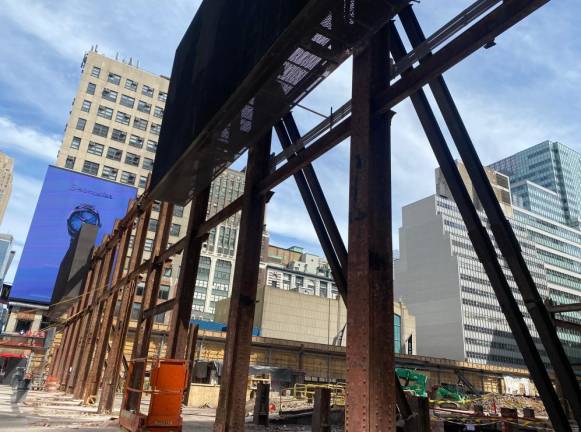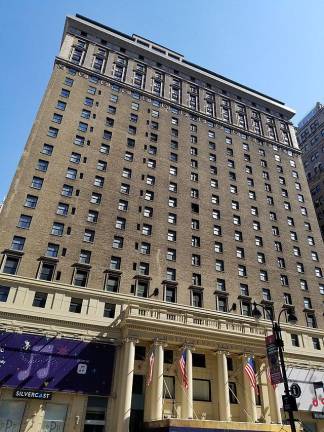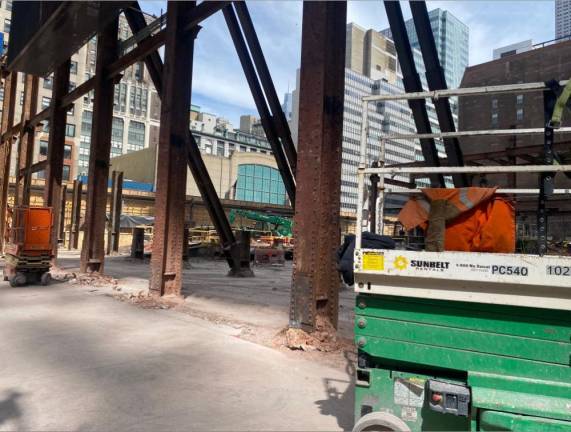Ode to the Hotel Pennsylvania
At its opening it was the largest hotel in the world and the only one to have its phone number, PEnnsylvania 6-5000, memorialized by Glen Miller and his orchestra. Current property owner Vornado Realty Trust postponed plans to build an office tower, but still went ahead and demolished the historic hotel.
The Hotel Pennsylvania is no longer.
What is left is a pile of rubble, ruins, untidy, heaped like a carcass, a battlefield. Now a patch of blue sky pierces your eyes where the hotel used to stand. The passersby, in their rush to get to Penn Station or Madison Square Garden, are stopped in their tracks, seized by a sense of loss, shock, and disbelief. It may even bring tears to their eyes. The hotel once stood, majestic and serious, across from the original Penn Station, the eastern part of a tryptic that started with the Farley Post Office.
When it opened in 1919, it was the largest hotel in the world. Too big to fail may have aptly applied to this giant. Hotel Pennsylvania endured death by a thousand cuts. Its loss was slow, pernicious, deliberate. For two decades, the hotel endured mild neglect, its façade’s grime and its bedbugs left unchecked.
The building’s downfall was a symphony of subtlety, never hitting a high note, always congruent with codes. It settled at rock bottom level in property maintenance, but city agencies, be they DOB or health inspectors, couldn’t find the owner negligent enough to label them delinquent. The long agony was made to justify the final coup de grace. Blame the brick because it can’t talk back. Demolition could have been averted. Many could have stopped the odious massacre, including the Landmarks Preservation Commission. No one ever claimed that the building had reached obsolescence. Even poorly managed and unloved, the hotel continued to attract tourists and visitors, drawn by the central location and the large number of rooms. The official headquarters for the Westminster Kennel Club Dog Show, canines of all sizes and shapes would rest their paws and fluff their coifs before their performance at Madison Square Garden. COVID was the final excuse to justify closing the hotel, severing hundreds of employees from their union jobs. We know what a superb job the hotel could have done in housing migrants who influx by the thousands to New York City. The loss of Hotel Penn was not precipitated by grand new plans, since its owner has conclusively declared he plans nothing for the site. So, what was the haste to demolish? Maybe a reactionary move against preservation activists’ vocal plea. It was easier to make the behemoth disappear than take the risk of a city agency deciding to do their civic duty and designate it a historic site. The hotel was witness and party to the pre-war grandeur of New York City. It was designed by William Symmes Richardson of the firm of McKim, Mead & White which also designed the original Pennsylvania Station located across the street. Built by the Pennsylvania Railroad, it was operated by Ellsworth Statler when it first opened. When it opened, it had almost 2000 rooms. Its front colonnade was made of solid blocks of Indiana limestone. Chunks of limestone that size do not exist anymore. The incarnation of the roaring twenties, the hotel was immensely popular for hosting events. The hotel’s past swarms with amusing anecdotes, stories of a gargantuan building that was a symbol of its time. In 1924, Harry Houdini exposed Joaquin María Argamasilla, a 19-year-old Spaniard who claimed he had X-ray vision. In the 1920s, Galveston crime boss Johnny Jack Nounes threw a $40,000 party at the Hotel Pennsylvania. Among the guests were silent film stars Clara Bow and Nancy Carroll, who were said to have bathed in tubs of champagne. William Faulkner stayed at the Hotel Pennsylvania while writing one of his many novels. Later, he would go on to receive the Nobel Prize for Literature. The hotel was a town within the city, with its own newspaper and all sorts of ancillary services. It had a studio that allowed broadcasting big band musical events, especially Glenn Miller’s. Café Rouge was the legendary big band venue where the most famous groups performed. Glenn Miller, Count Basie and Duke Ellington were regulars.
Entertainment always occupied center stage. Benny Goodman’s famous orchestra helped break the color barrier by including Harry James, Ziggy Elman, Gene Krupa and Lionel Hampton to the stage. They performed at the smaller jazz venue the Madhattan Room, located on the lower level of the hotel.
The hotel’s phone number, “PEnnsylvania 6-5000” made famous by Glenn Miller and his orchestra. The original hotel phone number, is said to be the longest phone number continuously in use in New York. When one calls today, a metallic female voice informs the caller that Hotel Pennsylvania is permanently closed but the voice does not volunteer that it is also permanently annihilated.
The hotel played a role on the international stage. In 1946, the American Russian Institute presented its first annual award to the late President Franklin D. Roosevelt at the Hotel Pennsylvania. On April 22, 1959, Cuba’s new revolutionary leader, Fidel Castro, stayed at the hotel. History does not say if the room was bugged. Sixty years ago, Hotel Penn stoically witnessed the demolition of the original Penn Station, probably hopeful that its fate would be different. At least, the train station died a public and violent death, a death that inspired eloquent writing, staunch outrage, and meaningful legislation.
Built in 1919
The memories of generations now lay in a dumpster. The marvel erected more than a century ago ended up in the architectural equivalent of a pauper’s grave, save a couple of items. A crystal chandelier that once adorned the lobby was spotted at a well-known antique shop on 57th street, bearing a $75,000 price tag.
What killed the hotel is not rudimentary greed. The culprit is irrational hubris, stubbornness, animosity. Some financial analysts have argued in private that the demolition may even go against the interests of the owner [Vornado Realty Trust] and that the company, a publicly traded REIT, had a duty to its investors to repurpose and adaptively reuse the hotel rather than to demolish it.
The now vacant lot will lay there for the foreseeable future. The market is not conducive to ground-up development. The owner is masterminding blight, maybe in hopes, as he did in Boston, to extract more public subsidies, crying for corporate welfare, while shaming the little people for trying to hold on to their homes or businesses.
The site is actually not exactly vacant. Shored up on 7th Avenue stand two giant billboards, held by massive grotesque steel beams–the same billboards that were once attached to the elegant façade. These blasphemous erections are mighty lucrative.
And now that the hotel is gone, the site’s property taxes have been reassessed as close to nil, a bad deal for the city coffers, but a good enough one for the owner. Saving Hotel Penn would not have been a heroic task. It would have been rational and prudent. It would have been sound public policy. Now we have lost more than a building. We have lost a sense of place, hundreds of tons of construction material, hundreds of tons of embodied carbon. We have lost considerable tax revenue. We have lost an opportunity to house our fellow New Yorkers. We have lost an entire page of our illustrious history.
This loss is an indictment of our urban planning process. The city has abdicated its role as a steward of our urbanism to the whims of developers whose impetus rarely align with the public interest. Yet, like capricious and tyrannical little monarchs accustomed to getting their way, they demand to be given subsidies and corporate welfare.A vacant site of this size is a burden this community cannot take. The site now vacant must be turned into a landscaped amenity that the public can use, while new plans are developed. Farewell, Hotel Pennsylvania. Farewell, dear friend. May you have not died in vain. May policymakers be jolted to pass meaningful legislation so that we don’t lose our historic fabric, and our tax revenue. And may our community be spared to live with a blighted vacant lot for the upcoming decade.
Layla Law-Gisiko is the head of the Land Use Committee of Community Board 5 in Manhattan and was recently named president of the City Club.
“This loss is an indictment of our urban planning process. The city has abdicated its role as a steward of our urbanism to the whims of developers whose impetus rarely align with the public interest.” Layla Law-Gisiko, head of CB5 Land Use Committee


